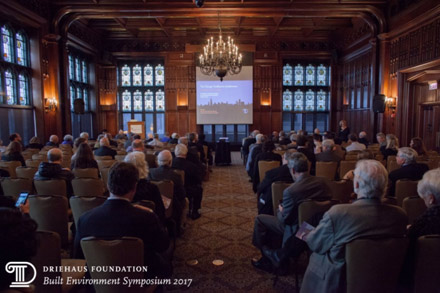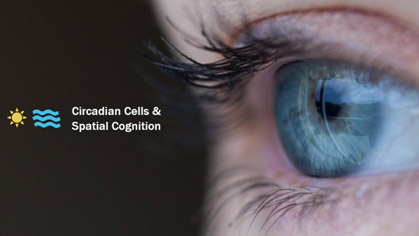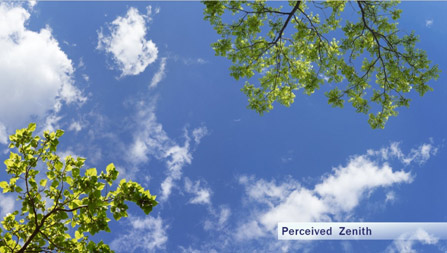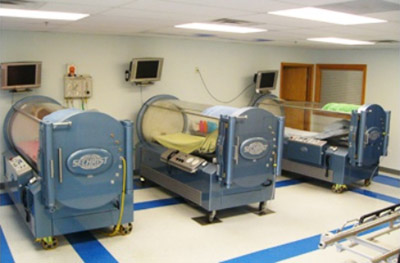
| Tradeshow |
Location |
Dates |
Event Center |
Booth |
| Leading Age |
New Orleans, LA |
Oct 29 - Nov 1 |
Ernest N. Morial Convention Center |
1853 |
| Health Achieve |
Toronto, ON, CA |
Nov 6 - 7 |
Metro Toronto Convention Center |
1424 |
| Healthcare Design |
Orlando, FL |
Nov 11 - 14 |
Gaylord Palms Resort & Convention Center |
1137 |
| Greater NY Dental |
New York, NY |
Nov 26 - 29 |
Jacob K. Javits Convention Center |
1806 |
| RSNA |
Chicago, IL |
Nov 26 - Dec 1 |
McCormick Place Convention Center |
1509 |


Driehaus Symposium:
Human Perception & the Built Environment
On September 30th, the University of Chicago Club hosted the Driehaus Symposium on Human Perception & the Built Environment. The event brought together leading academics and practicing architects whose collective work has advanced the field's understanding of how perceptual engagement with the built environment is a multisensory "whole organism experience."
The Symposium's purpose was to educate the public about advances in the biological sciences as they relate to what happens to our mind and body upon entering the built environment. Unlike the presumption that we can appreciate architectural space for its abstract qualities, it turns out that our instinctual reaction—formed the minute we walk into a room—trumps rational thinking.
As a matter of fact, our emotional response to the built environment is neurological. And it sets the tone as to whether we’ll favor diving into sensory exploration or withdraw, feeling distinctly isolated in the surroundings.

© Driehaus Foundation 2017.
The symposium was hosted by Architecture Professor Harry F. Mallgrave, distinguished architectural history scholar, Royal Institute of British Architects (RIBA) fellow, and author of the influential book, The Architect's Brain: Neuroscience, Creativity and Architecture.
Mallgrave's work has explored the parallels between the latest discoveries in the neurobiology of perception and the intuitive leaps made by historic architects. These parallels call for practitioners to reconsider architectural design as a trade where the senses, more so than conceptual thinking, are deeply complicit.
Among the most fascinating presentations was Dr. Barbara Lamprecht's session on Richard Neutra, considered one of the most influential modernist architects. Among his unknown contributions are Neutra's influential ideas predating many of biophilic design's most fundamental tenets, including the restorative attributes of a view to nature with Prospect & Refuge and the importance of designing interiors that "extend themselves into the environment as a means to heal the boundaries between them."
Equally thought-provoking was Sarah Robinson's session, The Space of Relation: Emotion in Architectural Experience, in which she underscored Frank Lloyd Wright's architectural cannon about embodied thinking, which understood the person and the building in the context of a broader ecology and was firmly rooted in "tangible observation, rather than abstract speculation." Such awareness bred a different type of modern architecture, one that restored wholeness, as well as the value of the intuitive in architectural craft.

© Driehaus Foundation 2017.
The keynote presentation was given by Juhani Pallasmaa, architectural theorist and practitioner, who is an Honorary Member of the Society of Finnish Architects (SAFA), as well as RIBA and AIA. He is the author of over 30 books, including the seminal The Eyes of the Skin: Architecture and the Senses, The Thinking Hand, and The Embodied Image.
Pallasmaa spoke about architectural space through the lens of art. He said artistic intuition shows us more about who we are, in a more exhaustive way, than the exponential powers of science. He also reminded the audience that architecture, as a discipline, has no formal framework of its own. It has traditionally borrowed from other fields depending on the interests of the time and place.
This piecemeal approach has led to various schools of architecture emerging over time, eventually leading to an education that emphasized abstract concepts over the practice of craft. Armed with a biological understanding of cognitive perception, the field is beginning to embrace architecture as a humanistic trade charged with the design of buildings as "soul anchors" (in the words of architect Richard Neutra) or sensoriums where all the residents' senses, as well as the mind, are engaged and nurtured.
The symposium showed how science is leading the way back to an architecture that is more humane, not only closer to nature, but an extension of it. The event was organized by the Driehaus Foundation, a Chicago-based organization whose philanthropic work includes supporting viable, healthy urban environments. The Foundation also supports art and culture, investigative reporting and government accountability, and provides opportunities for the working poor.
If you’re interested in the 2017 Driehaus Symposium thought-provoking sessions, they are now available on YouTube in nine sessions.

AIA Iowa Cohesion Workshop:
The Restorative Impact of Perceived Open Space
On September 29th, Sky Factory presented its new AIA CE course in the form of a workshop during Iowa's annual AIA Convention. The new course explores the restorative impact of perceived open space as an innovative, biophilic design technology capable of altering the way occupants experience isolated environments.
The course outlines the latest research from environmental psychology and neurobiology as it relates to how our perception engages with the built environment. The course describes how the careful staging of multisensory cues can give rise to therapeutic illusions of nature that can turn dead-end walls or sterile ceiling planes into architectural features that are comforting to the occupants of enclosed interiors.
While optical illusions have long history in Western Art & Architecture, the neurological underpinnings of this cognitive phenomenon have not been mapped until recently. With this new knowledge, it is possible to engage spatial cognition to connect enclosed interiors with an illusory—perceived—natural exterior, generating key wellness benefits. This cognitive framework expands the designer's toolkit. Architects are no longer be constrained by structural space, but instead can modify the impact of enclosed interiors on occupants.
The course explores the impact of deep plan buildings on occupants and how isolated, interior space tends to compress the spatial footprint of the occupant, significantly impacting his or her productivity, health, and cognitive function. Given that large commercial buildings have an average lifecycle of 80 years, retrofit solutions are the only viable solution to alter the deleterious impact of their design.

© Sky Factory 2017. AIA CE course slide, The Restorative Impact...
The workshop was also designed to raise questions about the way we view and understand light, particularly in relation to tunable artificial lighting, which modulates light intensity (irradiance) and color temperature to mimic daylight, indoors. However, at present, all dynamic lighting systems ignore or fail to account for the spatial attributes of daylight.
"When we transfer daylight-quality light indoors, light collapses into architectural space. It is no longer experienced within its natural, spatial medium—the sky," says Bill Witherspoon, Sky Factory founder and co-author of the white paper on which the new course is based. "Our physiology experiences daylight under the vastness of the sky. Yet, that visceral attribute—spatial relief—is gone, unreplaced, in isolated interiors."
There is growing interest in using tunable lighting systems to stimulate the circadian rhythm of occupants of enclosed interiors. However, there has been little emphasis made on daylight's spatial nature as an equally salutogenic attribute to human wellness.
In fact, among the fascinating studies cited in the course is new finding from a team based in the University of Manchester, in the U.K., who published a paper about circadian photoreceptors. The study is the first one to identify the "spatial distribution of light as being at least as large an influence on the master circadian clock’s firing as irradiance."

© Sky Factory 2017. AIA CE course slide, The Restorative Impact...
And while much remains to be understood about the circadian phase resetting, including the establishment of the Circadian Stimulus threshold and its duration, in view of other neural findings and the range of biological clocks our physiology harbors, it seems reasonable that the spatial attributes of daylight and the synaptic retinal data it transmits to the master circadian clock (in the hypothalamus) must play a valuable role.
Among the key insights included in the new course is the interrelationship between light, space, and memory; all of which comprise the fundamental building blocks involved in giving rise to environmental context. And context, whether structural or environmental, turns out to be essential in affecting the signal strength of visual input.
In other words, our cognitive faculties interpret visual input in relation to the cues our organs of perception detect around that input. This allows the keen designer to alter how the observer experiences the built environment.
Research in neuroscience has uncovered the deep connection between our ability to map space and how we form memories. These cognitive phenomena lead to the understanding that our memory stores our sense of space and environment as spatial reference frames.
How we perceive space and how we retrieve memories is a two-way street that can be used to trigger physiological reactions based on past environmental experiences. In this fashion, when we provide a visual stimulus that mimics a spatial relationship we are familiar with, the brain’s sensory and motor regions react as if the original memory itself was being re-experienced.
This is the stuff of which illusions are made. The new AIA course will be available as a lunch-n-learn presentation by 1Q 2018. Download the white paper on our research page.

Featured Application: Wound Care
Adding Spatial Relief to HBOT Healing
Can you remember the last time you fell off your bike and skinned your knee?
How long did you sit around letting the cut get some fresh air to kick-start the healing process? Now, imagine that the wound is not skin-deep, but is a much more complex one, deep inside you. And that to have it heal, your cells need to transport oxygen deeper into your tissues. But rather than let the process happen outside, surrounded by open space, you're placed in a sealed chamber.
How would you feel if you had to remain laying still in this enclosure for over an hour? What would your physiology feel about the features in the clinical space that held such a medical device? How could the doctors ease your discomfort at being isolated?
These are the questions that medical staff using HBOT for specialized wound care, ask.

© Misty Blue Cancer Center 2016.
Hyperbaric oxygen therapy (HBOT) is a standard procedure used in different types of acute and chronic wound care. Patients are placed in a supine position within a clear acrylic hyperbaric chamber, usually a cylindrical shape, which is then sealed before the pumping of pressurized pure oxygen. The higher pressure allows pure oxygen to serve as a catalyst that accelerates the healing process of damaged tissue. Patients remain inside these chambers for an average of an hour and a half to two hours.
By increasing the atmospheric pressure in a sealed environment, the patient's blood cells, blood plasma, cerebral-spinal fluid and lymph fluids can absorb more oxygen. The increased oxygen absorption enhances the physiology's ability to heal as oxygen-deprived tissues receive up to 20 times their normal oxygen supply. Oxygen-rich blood plasma diffuses up to 4 times farther into the tissues, repairing the damage generated by trauma or subsequent hypoxic (oxygen-deprived) conditions.
While the treatment is non-invasive and painless, the confined nature of the treatment and the artificial nature of the equipment used means patients need an environmental anchor that provides spatial relief and relaxes patients during the treatment. Distraction technologies like televised content are often used to occupy the patient's attention. However, this approach does not reduce mental agitation or the nagging feeling of claustrophobia, which often lurks inside the plastic curvature of the chamber.

© The Hyperbaric Medical Center 2012.
One of the most universal environmental features that deliver deep physiological relief is a view to nature. In highly artificial, clinical spaces it is possible to recreate the spatial reference frame provided by visual access to open skies through a multisensory illusion of nature. Personal Revelation SkyCeilings strategically placed above HBOT chambers give patients a front row view into an illusory sky so convincing that it generates an automatic "Relaxation Response" in the physiology.
This biophilic connection not only provides emotional relief, but it also engages spatial cognition and depth perception, which allows the patient to establish a visceral connection to a perceived open space. And the closer the observer feels to the outside, even if it's an illusory sky or panoramic view of nature, the sensory and motor regions of the brain identify the spatial reference frame with our memories of pleasant times close to nature.
This neural connection is much more than psychological. It provides a deep sense of physiological relief. As HBOT professionals seek to accommodate their clinical spaces to this type of treatment, noting how the ceiling plane or the walls can transform the patient experience through the use of restorative illusions of nature represents a higher standard of care that patients will remember long after the session has ended.

|



